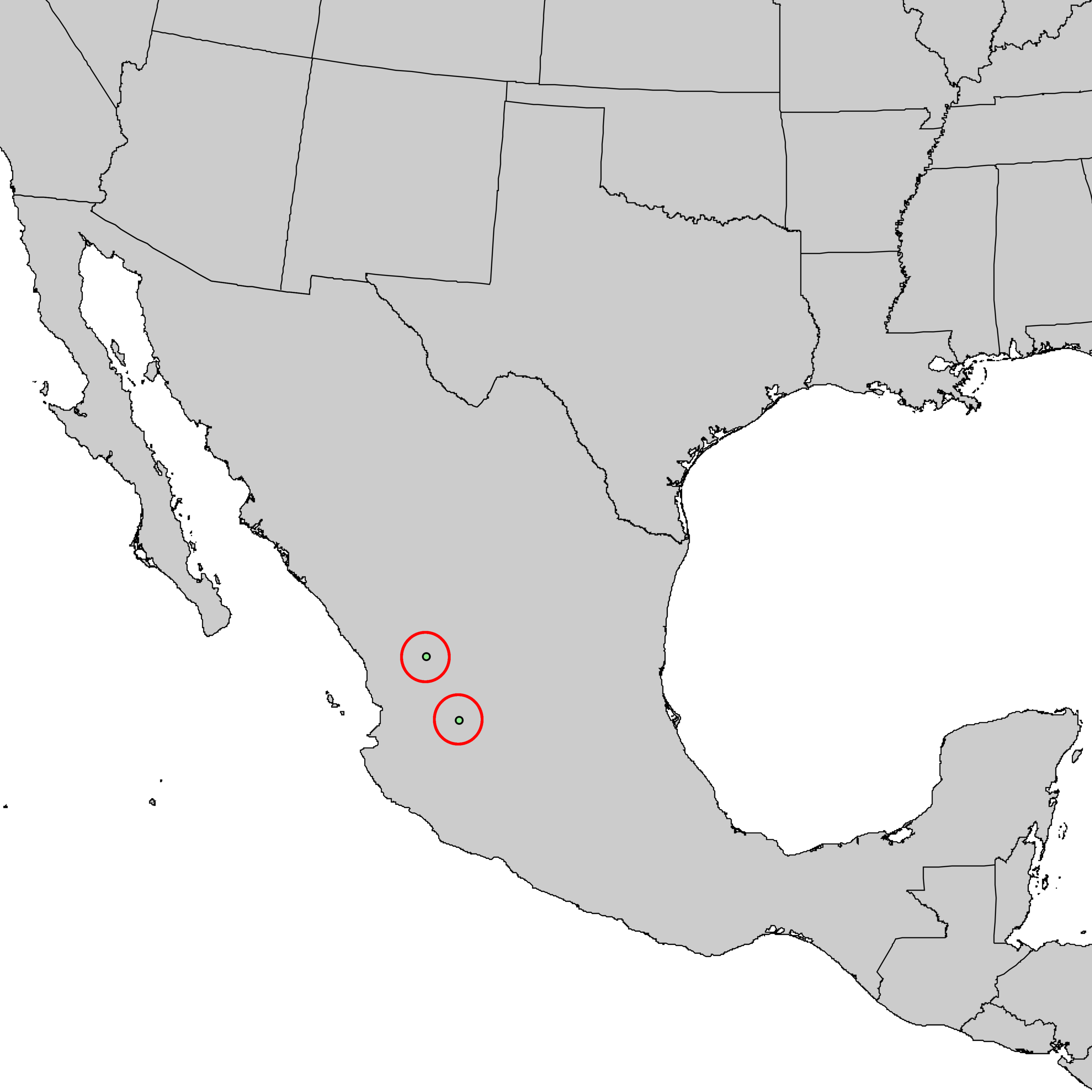Photo by Ruff tuff cream puff licensed under public domain
The maxipiñon (Pinus maximartinezii) is one of the rarest pines on Earth. A native of southern Sierra Madre Occidental, Mexico, nearly all individuals of this species can be found scattered over an area that collectively spans only about 3 to 6 square miles (5 – 10 km²) in size. Needless to say, the maxipiñon teeters on the brink of extinction. As a result, a lot of effort has been put forward to better understand this species and to develop plans aimed at ensuring it is not lost forever.
The maxipiñon has only been known to science for a few decades. It was described back in 1964 after botanist Jerzy Rzedowski noted some exceptionally large pine seeds for sale at a local market. He named the species in honor of Maximino Martínez, who contributed greatly to our understanding of Mexican conifers. However, it was very obvious that the maxipiñon was well known among the residents of Zacatecas.
The reason for this are its seeds. The maxipiñon is said to produce the largest and most nutritious seeds of all the pines. As such, it is a staple of the regional diet. Conversations with local farmers suggest that it was much more common as recent as 60 years ago. Since then, its numbers have been greatly reduced. It soon became apparent that in order to save this species, we had to learn a lot more about what threatens its survival.
The most obvious place to start was recruitment. If any species is to survive, reproduction must outpace death. A survey of local markets revealed that a lot of maxipiñon seeds were being harvest from the wild. This would be fine if maxipiñon were widespread but this is not the case. Over-harvesting of seeds could spell disaster for a species with such small population sizes.
Indeed, surveys of wild maxipiñon revealed there to be only 2,000 to 2,500 mature individuals and almost no seedlings. However, mature trees do produce a considerable amount of cones. Therefore, the conclusion was made that seed harvesting may be the single largest threat to this tree. Subsequent research has suggested that seed harvests actually may not be the cause of its rarity. It turns out, maxipiñon population growth appears to be rather insensitive to the number of seeds produced each year. Instead, juvenile tree survival seems to form the biggest bottleneck to population growth.
Photo by Krzysztof Ziarnek, Kenraiz licensed under CC BY-SA 4.0
You see, this tree appears to be more limited by suitable germination sites than it does seed numbers. It doesn’t matter if thousands of seeds are produced if very few of them ever find a good spot to grow. Because of this, scientists feel that there are other more serious threats to the maxipiñon than seed harvesting. However, humans are still not off the hook. Other human activities proved to be far more damaging.
About 50 years ago, big changes were made to local farming practices. More and more land was being cleared for cattle grazing. Much of that clearing was done by purposefully setting fires. The bark of the maxipiñon is very thin, which makes it highly susceptible to fire. As fires burn through its habitat, many trees are killed. Those that survive must then contend with relentless overgrazing by cattle. If that wasn’t enough, the cleared land also becomes highly eroded, thus further reducing its suitability for maxipiñon regeneration. Taken together, these are the biggest threats to the ongoing survival of this pine. Its highly fragmented habitat no longer offers suitable sites for seedling growth and survival.
As with any species this rare, issues of genetic diversity also come into play. Though molecular analyses have shown that maxipiñon does not currently suffer from inbreeding, it has revealed some interesting data that give us hints into the deeper history of this species. Written in maxipiñon DNA is evidence of an extreme population bottleneck that occurred somewhere between 400 and 1000 years ago. It appears that this is not the first time this tree has undergone population decline.
There are a few ways in which these data can be interpreted. One is that the maxipiñon evolved relatively recently from a small number of unique and isolated individuals. Perhaps a hybridization event occurred between two closely related piñon species - the weeping piñon (Pinus pinceana) and Nelson piñon (Pinus nelsonii). Another possibility, which does not rule out hybridization, is that the maxipiñon may actually be the result of artificial selection by agriculturists of the region. Considering the value of its seeds today, it is not hard to imagine farmers selecting and breeding piñon for larger seeds. It goes without saying that these claims are largely unsubstantiated and would require much more evidence to say with any certainty, however, there is plenty of evidence that civilizations like the Mayans were conserving and propagation useful tree species much earlier than this.
Despite all we have learned about the maxipiñon over the last few decades, the fate of this tree is far from secure. Ex situ conservation efforts are well underway and you can now see maxipiñon specimens growing in arboreta and botanical gardens around the world. Seeds from these populations are being used for storage and to propagate more trees. Sadly, until something is done to protect the habitat on which it relies, there is no telling how long this species will last in the wild. This is why habitat conservation efforts are so important. Please support local land conservation efforts in your area because the maxipiñon is but one species facing the loss of its habitat.


